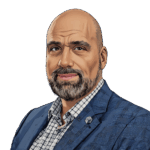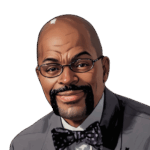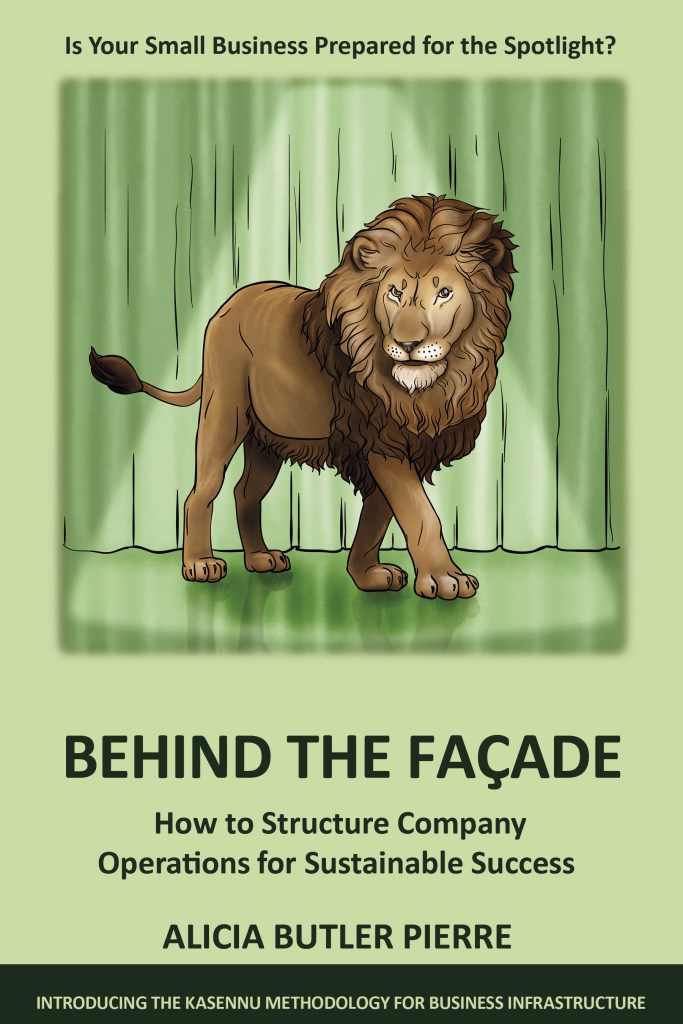Transcript
Hi! How are you? It’s great to see you again! Please, come in. Let’s go to the podcasting vault. We’ve selected our next episode to remaster and I can’t wait for you to hear it! As a leader seeking continuous improvement, you’ll definitely connect with this guest especially if you want to be on the cutting edge of technology.
This podcast is brought to you by Equilibria, Inc. We design business infrastructure that frees you from the chaos of fast growth, scales your operations, and increases the value of your small business.

This is Season 21 of the Business Infrastructure podcast. On this show we share operational tips, strategies, and tactics to help you cure any back-office blues you might be experiencing. I’m Alicia Butler Pierre and this season we’ve remastered some of our most popular episodes using our show’s new format.
We all have hopes, dreams, goals, and aspirations. And though the formula and the path for achieving them isn’t usually straight and narrow, we can always look to the accomplishments of others for inspiration to continue our pursuit. Listen, life is full of ups and downs and twists and turns. In fact, there’s a line in the movie Forrest Gump where the main character by the same name says, “Life is like a box of chocolates, you never know what you’re gonna get.” You know what? He was right!
As you seek to gain a better handle on your processes, build your all-star team, and invest in the right technologies, you’ll inevitably encounter unexpected obstacles that can undermine you, your brand, and your business. That’s why having a strong mindset, unwavering ethics, and a solid family foundation is critical to your success. We can’t go it alone. Study the path of any successful person in business and you’ll find that to be true. And our VIP guest today is no different. In the spirit of Frank Sinatra, she did it her way. Unapologetically.
This is Episode 267 – Leading Transformation and Becoming a CEO in Silicon Valley with Shellye Archambeau
Shellye Archambeau is one of the first African-American female CEOs of a high-tech company in Silicon Valley. She scaled MetricStream, a tech company providing risk management solutions, from a fledgling organization into a global powerhouse. One of her most recent accomplishments is the publication of her book, which Facebook’s former COO Sheryl Sandberg describes as a “Celebration of women knowing their power.” It was also featured as one of the best business books of 2020 by Fortune.
The name of Shellye’s book is Unapologetically Ambitious: Take Risks, Break Barriers, and Create Success on Your Own Terms. In this interview, we will discuss important lessons, strategies, and tips from the book that you can apply in leading your company. So, without any further ado, let’s welcome Shellye to the show, find out how she’s doing, and how her journey to becoming the CEO of a high-tech company began.

Oh, thank you. I’ve been looking forward to participating, Alicia, and I’m doing great actually. Let me tell you how honored I am that you enjoyed the book. That’s wonderful to hear. So, thank you for sharing that. With regards to starting out, I decided early that I wanted to run a company, not because I knew exactly what a CEO did, but because I had a guidance counselor who said, “You know business is kind of like clubs and organizations.” And I was in all the clubs in high school – French club, American field
service. National Honor Society. I was even a Girl Scout, but don’t tell anybody. So, when she said, “Well, clubs like business,” I’m like, Well, great! I love running these clubs, so I’ll go run a business. And it was literally that naive and audacious, but that then became the goal.
Following high school, Shellye began to execute her plan of becoming a CEO by applying to and getting accepted at the Wharton School of Business at the University of Pennsylvania, a top business school in the U.S. While there, she researched more about CEOs and eventually made some important discoveries.
When I looked at who are the CEOs, they didn’t look like me. And therefore, I’m like, all right, the odds aren’t in my favor yet again, so I’ve got to figure out, how do I improve the odds? And I figured having the best credentials I could was one key step. And then I’d heard that if you are involved and join companies that are in industries that are growing, then your company most likely will be growing. And growing companies never have enough resources. So, if you’re good at what you do, you can have more
opportunities to move ahead faster. So, I said, “Great!” And back in the early 80s, it was all about tech.
So naturally Shellye decided that she would become the CEO of a tech company, but which one and how would she reach that pinnacle?
I picked IBM because it was the Apple or Google or whatever of its day, and so a very prestigious company. I said, “Great, I’ll join IBM and just become CEO of IBM.” So, I looked at all the CEOs at IBM, and every single one of them started out in sales.
Well, I don’t know what the big deal is about sales, but obviously, it’s the path to power. So, I’m going to go join sales. And at the time, Alicia, people thought I was crazy. What do you mean? You’re graduating from Wharton and you’re going to sell computers? I mean, that’s not what Wharton grads do, right?

Wharton graduates, they go off to be like investment bankers and P&G product managers and international financial analysts and, I mean, all these cool, sexy, great jobs, and you’re going to go sell something?
I went against the grain. I started out in sales. And I’ll be candid, I leverage to this day more of the skills and experiences I had as a salesperson than any other in my career.
You learn so much. No wonder so many people in leadership start out in sales. And then I proceeded to work my way up the ladder at IBM, and I did well. I got to the point where I was the first African-American female sent on an international executive assignment. I was over in Japan. I was running a multibillion-dollar division. My boss reported to Lou Gerstner, the CEO. So, I’d done well, and nobody above me looked like me. It became kind of clear, unfortunately, that, You know what, despite all that
I’ve done, I don’t think I’m really going to get the chance to compete for CEO.
So, I decided that I needed to leave. Really a hard decision. I was basically born and raised at IBM, and it was hard to leave, but that was the right thing to do to actually go after my goal. So, I worked my way ultimately to Silicon Valley with a stopover at Blockbuster.com in the late 90s as president of Blockbuster.com, I was the chief marketing officer at EVPs sales of a couple of public companies, and then got my opportunity to be CEO of a very broken company that we managed to turn around over a
decade or so into a global market leader called MetricStream. And now I passed that baton a couple of years back, and now I serve on public boards and advise companies and universities, coach CEOs, and try to spend time on my passion projects.
Although Shellye just took us on a quick journey through her career’s timeline, I wanted to ask her about reaching that pinnacle. Because, as it turns out, being the CEO of a publicly traded company is not the top position. The top positions actually lie within the Board of Directors. After all, a board has the power to dethrone a CEO.
You know what? It was funny. I was probably in my early 30s before I really was made aware of this Board of Directors. I mean, I knew there was a Board of Directors, but I didn’t really understand what their role was. When I realized it was like, “Oh! Wait a minute, wait a minute. You mean the Board of Directors hires and fires the CEO? I want that job!” That’s the next aspiration – to become a CEO and then become a board member.
Let’s go back in time a bit and explore Shellye’s decision to work at IBM. From reading her book I knew that her dad worked his way up at IBM during the height of the civil rights movement in the U.S. Some 20 years later, Shellye began working there as an intern. I asked her if things had changed much from a workforce diversity perspective compared to the time her father was there.
It definitely had changed. I give IBM a lot of credit. IBM definitely leaned in towards diversity, just like they hired my father in the ‘60s, they actually were making a focused effort to hire women, to hire people of color. And so, when I got there, it’s not like there were plenty, but there were definitely enough that you didn’t feel you were the only one. When I started out in sales, in my branch office, there was one other black male salesperson, and I remember one black systems engineer, and there was myself. So, there might have been sales go-to-market side, maybe three, four of us. So no, not a lot out of a branch of 120 people.
Shellye worked at IBM for 14 years and though she didn’t become CEO there, she did go on to become the CEO at Blockbuster.com. Even then, female and minority representation at the C-suite level was still, as she described when I originally interviewed her, “far and few between.” But Shellye knows how to adapt. Listen closely as she retells one of my favorite stories from her book. It takes place during the time she lived and worked in Japan in the late 90s while still with IBM.
As I got ready to take this job, I was the first black woman that was being sent overseas. And I’m going to Japan, which is a very homogeneous place. My boss that I am leaving is trying to give me a pep talk, right?

He says, “Shellye, how much know of being successful in Japan?”
And I’m like, “Oh, not much. So please, I’m all ears. Tell me.”
He said, “Okay, there’s three things that are important to being successful in business in Japan.”
“Great, I’m all ears!” Got my pad, right?
And he says, “Number one, wisdom.”
Wisdom means age. I didn’t have that. I was in my mid-30s, so no, no gray hair. I was not in my forties and fifties have that wisdom. Okay, fine. No wisdom.
“Second is being male.”
And I’m like, “What?!” I’m zero for two.
So then he says, “The third is intelligence.” He said, “Shellye, you only have one going for you. You better figure out how to maximize it.”
That’s my sendoff speech.
So there Shellye was, young, unapologetically ambitious, and ready to relocate her and her family to Japan. As she pondered that sendoff speech, she had an epiphany.
Here’s what nobody realized, and I didn’t even realize until I was actually in the thick of it. I had been a minority or have been a minority in business my entire career. So, therefore, how I approach new situations is very different from someone who’s not been a minority. I know walking in the door to a new situation, people are going to underestimate me. They’re going to think that perhaps I’m there for reasons other than my skills and capability. And as a woman, I’m not going to get the benefit of the
doubt from a leadership standpoint. I’m going to have to prove it. So, therefore, I always start things the same way. I use a servant-leader approach. I focus on the team and try to make the team successful. If they’re successful, I’ll be successful. That builds loyalty, et cetera. I show I care.
Despite the odds being stacked against her, Shellye became successful while in Japan fairly quickly. Through her servant leadership approach, she was able to use language to build trust and bridge ideas. In one of her first meetings there, she made it a point to have certain parts of her presentation translated into Japanese. It showed she respected their culture and was serious about making sure her ideas were properly conveyed without any misunderstanding.

It was that approach of focusing on how to help the team be successful. I’m going to optimize for the team versus optimizing for me. Well, what I learned and what I tell people is, “Hey, if you’ve been successful as a minority, whether it’s a person of color or a woman in business in the States, go do an international assignment because you actually have an advantage that you don’t even realize because other people, walk into that experience, it’s the first time they’ve been a minority, and they don’t get it.”
Why aren’t people listening to me? Why won’t they just do what I tell them to do? It takes time for them to get themselves situated.
Considering Shellye’s domestic and international work experiences, it begs the question, how does she, as a leader, define a diverse workforce?
I use the broadest definition, which is a diverse workforce means that you have a whole range of people with various racial, ethnic, socioeconomic, and cultural backgrounds, different lifestyles, different experiences, interests, and maybe religious. To me, diversity is a spectrum and the most diverse has the biggest variety and range of people working together.
So, if Shellye describes diversity as a spectrum, I wondered what her thoughts were regarding measuring diversity. In other words, should diversity have targets or KPIs and if so, does that make diversity yet another item to check off on a list of things to do?
How do you know what good is if you don’t have a target or a measure? You might run down a track and think, Hey, I ran well, I ran fast. But you don’t know if you actually did until you know, well, how are others running?
How do you know that unless you’re actually timing yourself, right? And then seeing what happens if you actually strengthen your legs and do and now run now, how are you running? So, to me, in order to determine any kind of performance, you have to put some kind of measure on it.
And in business, we measure everything that’s important. We measure revenue growth, we measure profitability, we measure customer churn, we measure customer satisfaction, we measure employee satisfaction. Why do we measure those things if we just were doing what we’re supposed to be doing, right? It should all be good, but we don’t know that the actions that we’re taking are actually effective. And that’s why we need to measure, right? So, when it comes to diversity, I see the same thing. It really is important. We should have metrics, and then we should see how we are doing against these metrics.

During the original interview, I jokingly told Shellye it seems as though she has a crystal ball that she looks into to predict business trends and plan accordingly. Coming up after the break, she’ll explain more about how she scaled MetricStream when she became CEO as well as other valuable leadership tips.
In the world of business, success isn’t just about great ideas or products. It’s about having a strong foundation—a solid business infrastructure. But why is it so important?
A robust business infrastructure is like the backbone of an organization. It provides the necessary support for all our operations.
Business infrastructure ensures effective communication and collaboration. It allows teams to seamlessly share information, work together efficiently, and make informed decisions.
It also enables efficient data management. With proper systems in place, businesses can securely store, analyze, and utilize their data to gain valuable insights and make strategic decisions.
Thirdly, a strong business infrastructure promotes innovation and growth. It provides the flexibility to scale up operations, adopt new technologies, and adapt to changing market demands. It’s no wonder why a solid business infrastructure is essential for success. It enhances communication, facilitates efficient data management, fosters innovation, and enables flexibility—all vital for businesses to thrive in today’s competitive landscape. Invest in a strong business infrastructure, and watch your business reach new heights!
At Equilibria, we’re excited to offer a free webinar opportunity where we’ll do a deep dive into business infrastructure. Stop being a victim of unmanageable fast growth and start building your own company’s business infrastructure. Don’t wait! Experience the order and calm that thousands of other small businesses have. Sign up now at SmoothOperator.Club. That’s SmoothOperator.club.
We’re back and before the break, Shellye Archambeau gave us a glimpse into her journey from a bright-eyed teenager with ambitions of being a business leader to becoming a CEO of a publicly traded tech company in Silicon Valley. In listening to her, she definitely has a knack for studying trends, developing plans, and executing them. Now she’ll share her predictions for remote working, how to delegate effectively, and why falling in love with your market is essential for scaling your business. But first, she’ll share with us why connection is critical for effective communication as a leader. Here’s Shellye.
What I find is face to face and in-person allows you to make a stronger connection. Because the three-dimensional person is just more complete than a two-dimensional person. A two-dimensional person is a face you see on a screen, but you’re not seeing everything. You don’t see the full body language; therefore, you don’t see the full communication that’s happening or going on. Connection can be a little harder.

When you’re in person, the energy you can almost feel. It’s hard to feel those things in two-dimensional. Maya Angelou…People don’t remember what you say. People don’t remember what you do, but they remember how you make them feel. I just believe a personal connection gives you the ability to create a deeper feeling, which will then create a deeper memory and therefore relationship that you can build on even if you see somebody just once. And every other interaction is phone, video, whatever,
that’s fine. But the fact you had that as a base is important.
And I think just about everybody can think through people that they’ve had a chance to meet in person and then gone on right to not. I have a friend to this day, my son is 32 years old, and we’ve been friends since before my son was born.
And every time we get on the phone, even though she lives across the country, we don’t see each other very much at all. We’re right back where we were. And I don’t care if it’s six months, eight months, whatever we got, and we’re right back. Well, it’s hard to have that kind of depth of connection just having met somebody only on Zoom or only on a conference call.
I completely agree with Shellye. There’s something magical about meeting with someone in person, even if only once. It leads to a deeper connection which can further evolve into a trusted business relationship. With this in mind, Shellye talked in more detail about another topic featured in her book – the importance of building a network.
A network, a true network, is nothing more than a set of relationships. And I define a network as comprised of people who will do something for you when it’s not convenient. It’s not how many business cards I have. So, building that takes intention. And I believe if you have the ability to meet people in person, always take that opportunity.

Going back to Shellye’s crystal ball, I wondered if she could talk about the future of work and her predictions about whether more companies, both large and small, would adopt fully remote work.
I think there’s going to be very few companies that have the same number of people coming to the office every day post-COVID, as pre-COVID. I just don’t see it. I think it’ll be a hybrid. Okay, a couple of reasons.
One is employees. Many want to get back to the office. We want to see each other; we want to interact. But at the same time, we also want flexibility. This has been hard, for sure, but there’s also been a number of advantages that people have learned.
They’ve learned that, Oh, I actually can be productive, and I can actually handle more things as a result of actually being home. Not that they want to be home all the time, but a day a week, two days a week, I think people want that. And businesses have learned, you know what? Business doesn’t stop just because people are actually working remotely. We can get things done. And so, employees want this, and so do we. Especially in an environment where it’s hard to hire people.
You have to do things that are going to attract people and retain people. And so, if I’m not going to be flexible but Company B is going to be flexible, who’s going to have a better opportunity to hire the best talent? Company B. You know, I personally believe that there’ll be much more hybrid in the overall approach than there has been before for sure. And I do think there are some jobs out there that won’t be going back into the office. So, it’s going to be more of that. I think it’ll be a rarity for companies that
have everybody back in the office every day just like normal.
This is especially true for people like me who live in cities plagued with traffic. As someone who started using Zoom well before the pandemic, I can personally attest to my productivity skyrocketing when I started conducting more meetings remotely.

Oh, listen. Think about it. That was absolutely part of the productivity that people have experienced and that they still want – was just that! It’s like, “Oh, wait a minute, if I’m not commuting 2 hours a day, look how much more I can get done.” And that’s a personal statement and a professional statement. In the first four months of COVID, every company saw an increase in productivity, which was a shock.
And I think a big piece of that was just that one, you don’t have any commutes, so what are you doing with that time? Two, people weren’t taking care of themselves, so they were working too much because they didn’t have boundaries anymore. I mean, if anything, many companies saw, at least in the beginning, having to just figure out ways to get people to stop working.
So, this whole notion of I’m working remotely and suddenly I’m not working, I think they’ve realized that, hey, people actually do work.
Speaking of people actually doing the work, this is a great place to segue into a deeper conversation with Shellye around business infrastructure. Reed Hoffman, the co-founder of LinkedIn, described her as, “…the woman who pulled off the most incredible Silicon Valley turnaround you never heard of.”
That turnaround he’s talking about is MetricStream. I asked Shellye if we could talk more about the dramatic transformation she led while serving as CEO there from a business infrastructure perspective – that is, developing the people, processes, and tools to turn the business around. How’d she do it?
It really starts first with creating a value proposition and an organization that people actually want to be a part of. So that’s the first step. And that was my biggest challenge. I walked into…the company called Zaplet. That was the original name of the company. And they were struggling. They built some amazing technology, but they had, in my opinion, fallen in love with their product. And when you fall in love with your product, you put yourself at huge risk. They had this terrific product that nobody wanted. It’s so important to actually fall in love with the market because when you fall in love with your product, nobody can tell you your baby is ugly.
When you fall in love with your product, your product becomes like your baby. And you can’t even hear the feedback. You become defensive. You’re like, of course, your product’s perfect. It’s the client that doesn’t get it, right? No, the key is you want to fall in love with the market. Because when you fall in love with the market, you do everything in your power to nurture the market, to make sure you understand the market to meet all of its needs, and to anticipate what its problems might be.
Duly noted. So, how exactly do you fall in love with your market? Shellye answered this by continuing to use MetricStream, as an example.
First of all, who is your market? So, I needed to find metrics for Zaplet, right? I need to figure out for Zaplet who is our market, what is the problem we’re going to solve, and for whom. And that was a huge question and challenge. And to solve that, I just went out to find the smartest people I know and talk to them. I try to read a lot. I try to do all these things to learn from others who have much broader perspectives than I do, and then just piece it all together.
And literally, I spent months out there. Talking, interacting with people to say, What is a big problem that businesses have that’s not being solved right now? And I didn’t ask people what I should do with the company. I just wanted to find out the problem. Because if I could figure out a problem to solve, fine, then I can figure out my market, and then I can figure out the product to solve the market’s problems. And that’s how we came up with the whole compliance and risk thing. Companies are struggling under the burden of all these regulations that are coming down with Sarbanes Oxley. And back then it was WorldCom Imploding, and all the different rules and CEOs were struggling.

And I’m like, “Done! We’re going to figure out how to help companies manage compliance and risk.” And once I had a problem, now I can create a vision. We’re building a company that’s going to help other organizations manage compliance and risk so they can effectively manage and grow their businesses. Do you want to be a part of that?
Also now, I can create a vision. And with a vision, I can start recruiting people because I can tell them what they’re joining and what they’re going to be a part of and what’s the big world problem we’re going to solve together. And here’s what this means for the companies. Here’s what it means for us. Here’s what it means for you.
That’s how you start to build your team. Because the key is you want to get the best, talented people you can find, and hopefully a whole lot smarter than you are. Fortunately, I had great investors and found a company, MetricStream was their name. They were doing quality and operational compliance things. And so, we put the two together because that gave us a little bit of a leg up on how we get a solution to solve the problem, et cetera. Then from there, we built the company one person at a time, but all about trying to find the best talent we could to help us deliver against this vision.
Delegation is one of the skills that I see that tends to hold people back from moving into the highest levels of business. Because at the end of the day, when you start your career, it’s all about what you do, what you’re able to create, how you interact with others. What you actually create as you move up the organization. However, you’re going to be judged on not just what you do, but how well you get work done through others in a consistent way, and how well you develop others. So, if you aren’t good at delegating, you’re going to get to the point where you get stuck.
Did you hear that? Pay close attention as Shellye describes why you can get stuck as a leader if you’re ineffective at delegating.

Delegation is important because how you spend your time needs to change. You can go from You’re the one that does all the work and gets things actually done to Yes, you do some things, but you need to spend time thinking more about strategy, thinking more about the market, thinking more about building relationships beyond your immediate organization. Because you need these relationships to make sure that you can actually support your team right and get things done.
And if you don’t have the bandwidth to spend time on those kinds of things, you’re not going to be able to participate effectively in conversations and meetings that talk about where should we go. Not where are we going? What should we be doing? Bringing new ideas. I mean, it’s not like this whole notion of a light bulb suddenly going off. It doesn’t unless you spend time thinking!
Most people don’t have time to think. I can’t tell you how often I would talk to people who work for me to say, “Listen, you need to figure out how to set aside 5, 10% of your time just to think.” And if you’re doing all that time, you’re not thinking. So, delegating is super, super critical to learn how to do, because if you can’t delegate effectively, then you’re going to end up either micromanaging or constantly having to fix. And if you’re having to do that, then your teams are not going to be as effective because if they’re
reworking, reworking it’s going to take them way too long. So, I encourage everybody to learn how to delegate.
We could do a podcast, even an entire season on how to delegate but Shellye brilliantly summarized the art of delegation in just a few sentences.
Delegating is basically not assigning a task. If I say, “Alicia, you need to go do X, Y and Z,” that’s not delegating. You’re just being directive and you, Alicia, aren’t learning that process because you’re just, okay, do x, y, and z. No thought, right? No process, no negotiation. No delegation is, “Alicia, we need to accomplish x, and I need you to lead this effort to build a plan on how we’re going to accomplish x. The plan should include these elements. That’s delegating, because now you have to think about it, and
in that process, you’re going to be learning, not just doing.
And it also sounds like you are empowering that other person and giving those people the autonomy to be able to do whatever work they’ve been delegated effectively.
Definitely.
Wow, so let’s see…we’ve covered how to effectively delegate, scale your business by falling in love with your market, leading transformative change, and giving your team interview, I asked Shellye if she could share resources she recommends to stay abreast of business trends. what they need to be successful among other things. As we started to wrap up our interview, I asked Shellye if she could share resources she recommends to stay abreast of business trends.
Yes. And again, I tend to be more focused, obviously, on tech. In terms of what’s happening there. So, when you say what resources, things like Tech Crunch is one that tell you what’s going on, what’s happening, et cetera. Tech Hive is another one that gets information. A number of venture capitalists, Andreessen Horowitz is one that I like to follow, they put out a blog where they cover all kinds of different topics and what’s happening. There’s Digital Trends, which focuses on digital transformation. Then some old-school ones. I still like to read The Economist.
I like The Week, which is a news magazine that comes out weekly that basically gives both sides of all issues. Here’s what happened. Here’s the view from a conservative perspective. Here’s the view from a liberal standpoint. Here’s the center view. So, all these things help me just keep abreast of what’s going on and try to understand what’s actually happening, not what others think is happening when it comes to what’s going on. So those are a few of the things that I would highlight.
And of course, I’d be remised if I did not ask Shellye to talk more about her book which anchored this conversation.
Thank you! Yes. So Unapologetically Ambitious: Take Risks, Break Barriers, and Create Success on Your Own Terms. I wrote the book because everyone deserves to be ambitious, and no one should have to apologize for it. And I wanted to provide the tools, the techniques, the approaches, the hacks, what worked, what didn’t work in terms of improving your odds to get what you want out of life professionally, for sure, but also personally, because many of the same skills and tactics and things that you use to be successful professionally also work personally and vice versa.
It’s all about being intentional. Thinking through what are you trying to achieve in the future and what can you do today that will better prepare you to make that happen? And in doing that, I find you tend to improve your own luck.
Well, I must say, what I found most refreshing about your book is not only do you share your story and talk about what you did, but you literally spell out how you did it. It really is a blueprint.
Well, thank you very much, and thanks so much for having me!

Let’s give Shellye a warm round of applause! You can find her book, Unapologetically Ambitious, wherever books are sold online. Grab a quick link to her book, and her personal website, as well as links to the other resources she mentioned at BusinessInfrastructure.TV. Again, that’s BusinessInfrastructure.TV.
Thank you for listening! If you enjoyed this episode, then please subscribe and leave a five-star rating and review.

Okay, well it’s time to leave the podcasting vault. I’ll walk with you back to the front door. Before you leave, again, make sure you subscribe to this show so that you’ll know when to come back and listen to our next remastered episode. It features someone near and dear to my heart – someone I credit with the success of this very show.
Until then, remember to stay focused and be encouraged. This entrepreneurial journey is a marathon and not a sprint.
This podcast was written, produced, and narrated by me, Alicia Butler Pierre. Audio editing by Olanrewaju Adeyemo. The original score and sound design by Sabor! Music Enterprises.
This is the Business Infrastructure – Curing Back-Office Blues podcast.





















